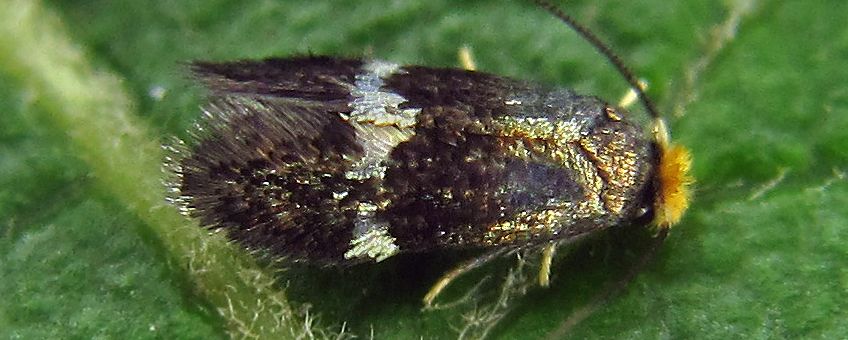
The relativity of rareness: most European specimens of Gold-fringed Pygmy found in just two countries
Naturalis Biodiversity CenterOn 13 June 2018 during a public mothing event in Eilenriede, the city forest of Hannover, Tina Schulz found the first German specimen of the rare pygmy Bohemannia auriciliella (Gold-fringed Pygmy). Naturalis researcher Erik van Nieukerken confirmed the identification, and from this contact a joint paper originated that reviews all records of this species. The paper was published on 15 September in the journal Entomologische Zeitschrift, Schwanfeld. The abstract still states that in total 28 specimens are known from Europe, but during the period that the manuscript was with the editors, remarkably quite a few new specimens were observed in 2020, leading finally to a Note at the end of the paper that corrects the total to 38 specimens, although this still is quite a small number.
Erik van Nieukerken said: “I do not trap moths at light frequently, but during this year’s heat wave in June I attempted it twice during a short holiday and not very seriously intended to find this species. To my surprise indeed a female of the species landed on my sheet! Never had I found this species before, but I did identify several in collections of others.” Also Dieter Robrecht found this year the species again in Germany, two specimens in Nordrhein-Westfalen, identified by Erik.
It is remarkable that 28 moths have been observed in just two countries: England with 17 and the Netherlands with 11, the other were found in France, Germany, Switzerland, the Czech Republic and Bulgaria. This unequal distribution seems to be mainly caused by the much larger interest in Microlepidoptera in these two countries. Remarkably no new records were given on observation sites, whereas the closely related Bohemannia quadrimaculella has been reported frequently on such sites, especially in the Netherlands.

How do we explain this rareness?
Still few people collect, observe or photograph moths of the size of most pygmy moths, and those who specialise in the group prefer to search for leafmines in the first place. The biology of the Gold-fringed Pygmy is poorly known, there is some indication that the caterpillar feeds in branches or buds of birch, but some records in the Mediterranean region suggest that there may be alternative host plants. When the life history will be known, and it will be easier to find the caterpillars, we expect an increase of records. On the other hand, some species are so elusive that they remain very hard to find.
It is clear that we need to be careful when characterising species as rare; real rarity is usually connected to special and rare habitats or in the case of moths and butterflies often also a rare or decreasing host plant. The Gold-fringed Pygmy seems to be an inconspicuous moth, that isn’t particularly critical about its habitat. Apparently it is so elusive that it is usually simply not seen.
Recognition
The Gold-fringed Pygmy is relatively easy to recognise by a combination of a scape (eyecap) with the posterior quarter grey, the brassy basal quarter of the forewing, the pair of silver spots and the golden fringe. It is one of the medium large Nepticulidae with a wingspan of six to seven millimeters.

More information
- Source: The elusive pygmy moth Bohemannia auriciliella (De Joannis, 1909) (Lepidoptera: Nepticulidae): overview of its distribution, with new records for Germany and Bulgaria (pdf; 2.3 MB)
- Lepiforum
- Lepiforum Bohemannia auriciliella
- (Some) observations in the Netherlands
Text: Erik van Nieukerken, Naturalis
Photos: Tina Schulz; Erik van Nieukerken
